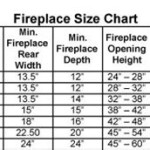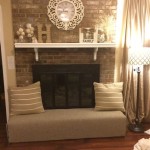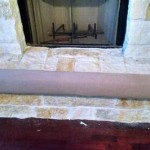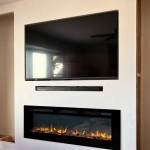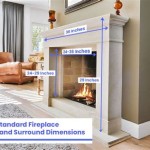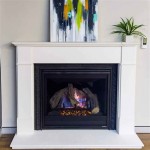Vented Propane Gas Log Fireplace: A Comprehensive Overview
Vented propane gas log fireplaces offer a blend of aesthetic appeal and functional heating for residential spaces. They provide the visual ambiance of a traditional wood-burning fireplace while utilizing the convenience and relative cleanliness of propane gas fuel. Understanding the mechanics, benefits, and considerations associated with these systems is essential for homeowners contemplating installation or those seeking to optimize the performance of an existing unit.
A vented propane gas log fireplace operates by burning propane gas within a pre-fabricated firebox, typically made of metal or refractory materials. The "log set," composed of ceramic fiber or refractory cement logs, is arranged atop a burner system that distributes the gas for combustion. The design of the log set aims to mimic the appearance of burning wood, providing a realistic flame pattern and ember glow. The term "vented" refers to the requirement for a functional chimney or vent system to exhaust the combustion byproducts, including carbon dioxide and water vapor, to the outside atmosphere. This distinguishes them from vent-free gas log sets, which are designed for different applications and possess distinct operational characteristics.
Key Point 1: Operational Mechanism and Components
The core components of a vented propane gas log fireplace include the burner assembly, the log set, the control valve, and the venting system. The burner assembly is responsible for mixing propane gas with air in the correct proportion to ensure efficient and clean combustion. This assembly commonly includes a pilot light, which provides a small, continuous flame to ignite the main burner when the fireplace is activated. The control valve regulates the flow of propane gas to the burner, allowing for adjustment of the flame height and heat output.
The log set serves as the visual focal point of the fireplace. Made from heat-resistant materials, these logs are meticulously crafted to resemble natural wood, often incorporating intricate details to enhance realism. The arrangement of the logs is crucial for optimal flame distribution and aesthetic appeal. The venting system, typically a chimney or flue, is essential for safely removing combustion byproducts from the dwelling. Proper sizing and maintenance of the venting system are crucial to prevent the buildup of harmful gases within the home.
The ignition process usually involves activating the pilot light, either manually or electronically, followed by opening the main gas valve. The escaping gas is then ignited by the pilot light, creating a sustained flame that heats the log set and radiates warmth into the room. The intensity of the flame can be adjusted using the control valve, allowing for customization of the heat output based on individual preferences and ambient temperature. A safety mechanism known as a thermocouple or thermopile is typically incorporated to shut off the gas supply if the pilot light is extinguished, preventing the accumulation of unburned gas within the firebox.
Key Point 2: Advantages and Disadvantages
Vented propane gas log fireplaces offer several advantages over traditional wood-burning fireplaces. They provide a convenient and relatively clean-burning alternative, eliminating the need for wood storage, chopping, and ash disposal. They ignite quickly and easily, offering instant warmth and aesthetic appeal. The adjustable flame height provides a degree of control over heat output that is not possible with wood-burning fireplaces. They also often boast a more consistent and predictable burn compared to wood-burning options.
However, vented propane gas log fireplaces also have certain disadvantages. A significant consideration is their lower energy efficiency compared to vent-free models or other heating appliances. A substantial portion of the heat generated is lost up the chimney or venting system along with the combustion byproducts. This venting requirement also necessitates the presence of a functional chimney or flue, which may not be available in all homes. Installation costs can be higher than vent-free alternatives due to the complexities of venting system modifications or construction.
Furthermore, while propane is generally cleaner-burning than wood, it still produces combustion byproducts that can pose health risks if not properly vented. Regular maintenance, including chimney cleaning and inspection, is essential to ensure safe and efficient operation. The aesthetic realism of the flame and log set, while often appealing, may not completely replicate the authentic experience of a wood-burning fire for some individuals.
Key Point 3: Installation and Safety Considerations
Professional installation of a vented propane gas log fireplace is strongly recommended to ensure proper operation and safety. A qualified technician can assess the existing venting system, ensure proper gas line connections, and verify compliance with local building codes and regulations. Improper installation can lead to gas leaks, carbon monoxide poisoning, or fire hazards.
The venting system must be appropriately sized for the fireplace to ensure adequate draft and prevent backdrafting of combustion gases into the home. Regular inspection and cleaning of the chimney or flue are crucial to remove creosote and other debris that can obstruct airflow and increase the risk of a chimney fire. A carbon monoxide detector should be installed in the vicinity of the fireplace to provide early warning of any potential leaks.
Homeowners should familiarize themselves with the operating instructions and safety guidelines provided by the manufacturer. Never store flammable materials near the fireplace, and avoid obstructing the venting system. Regular maintenance, including cleaning the burner assembly and inspecting the log set for damage, contributes to the longevity and safe operation of the fireplace. It is imperative to schedule annual professional inspections to maintain the integrity of the system and address any potential issues promptly.

American Gas Log Cheyenne Glow 18 In Vented Propane Fireplace Set With Complete Kit Safety Pilot Lit Cg18hdlp The Home Depot

Hargrove Inferno See Through Shallow Vented Gas Log Set With System 4 Burner Propane Specialized Hgissss S4b

How To Choose A Propane Gas Log Set Admiral

Elevation 36 Direct Vent Fireplace Propane Electronic Ignition

Grand Canyon Quaking Aspen Double Sided Vented Gas Log Set With Stainless Steel Burner

Hargrove Western Pine See Through Shallow Vented Gas Log Set With System 4 Burner Propane Specialized Hgwpsss S4b

Gas Logs Ham County Nearby Lg Jordan

Hargrove Mountain Timber Vented Gas Log Set With Ansi Certified System 4 Burner Kit Propane Specialized

Fireplace S In Tenneessee Gas Logs More Admiral Propane

Ventis Allegheny Vented Gas Log Set 18 To 30 Rockford Chimney

